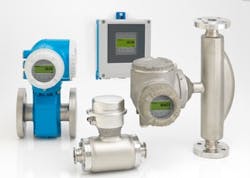E+H Proline 300/500 Smart Coriolis Mass Flowmeters
Endress+Hauser is launching its Proline 300/500 smart Coriolis mass and electromagnetic flow instruments that simplify installation, speed commissioning, and streamline operation and maintenance.
Proline Promass Coriolis mass flowmeters are available in 11 models from 1/24 to 14 in. in diameter for measuring flows up to 100,000 tons per day. Proline Promag flowmeters are available in sizes from 1/12 to 78 in. for volume flows up to 634 mgd. Equipped with aluminum, hygienic stainless-steel or cast stainless-steel housings, Proline offers flexibility for all environments including high temperatures, corrosive fluids, hygienic and sterile. The 300 series are compact with the transmitter mounted integrally to the sensor, while 500 series provides remote accessibility of the transmitter from sensors.
"Proline 300/500 have capabilities tailored to meet the needs of different industries, but we want to assure our customers this is a natural product extension and evolution for Proline and our Promass and Promag sensors, which have been tried and tested for decades," says Nathan Hedrick, flow products marketing manager at Endress+Hauser Inc. "One advance is implementation of redundant, traceable references to avoid undetected drift in measurement. At the same time, we maintained the same dimensions of the sensors for easy drop-in replacement. This means users can experience new benefits without big changes or risks."
Proline 300/500 lets users access signals and data through HMIs to match plant preference. Access is through a local, four-line, backlit, optical display, embedded web server, digital communication protocol, handheld device, asset management or other solutions, such as Endress+Hauser’s W@M lifecycle management software or secure WLAN. It was integrated into the optical displays to permit access from handhelds like tablet PCs or smart phones from a common web browser. Each method enables fast commissioning, in-situ device verification during operation, access to diagnostics and automated on-board data storage.
One of Proline 300/500's new innovations is its three-part Heartbeat Technology with remedy-based diagnostics, monitoring and verification for satisfying regulatory, contractual, quality, safety or fiscal requirements. First, Heartbeat Diagnostics provides permanent self-monitoring for all Proline instruments meeting NAMUR NE107 requirements for event categorization and device remedies. Second, optional Heartbeat Monitoring identifies device trends from process influences, such as buildup, settling solids or liquids, erosion, corrosion and multi-phase fluid flows. Third, TÜV-attested Heartbeat Verification is an in-situ verification method that can be triggered from anywhere to provide electronic quality reports. It's also the only method that's achieved third-party accreditation per traceable ISO metrological standards in operation.
"These remedy-based diagnostics tell users on the display or any HMI what steps are needed to resolve the event faster and safer than ever," says Hedrick. "Also, having Heartbeat Verification in the transmitter means device verification with audit safe documentation takes 5 minutes or less, where they used to take at least 15 minutes and often longer."
To automatically protect data storage, every Proline instrument uses a unique HistoROM concept, which includes an onboard event logbook and data logger that can be accessed locally or remotely to store operating, calibration and verification data. "For example, when Proline 300/500 detects a half-full pipe, it's immediately noted in its HistoROM logbook, which can be called up any time or accessed via the web server. This allows more traceable measurements and visibility to events the meters experienced," adds Hedrick.
HistroROM also makes it easier to replace or repair flowmeters because its operating firmware is resident in device memory. “A common complaint was the risk a component exchange introduced from software incompatibility into the customer's controls," adds Hedrick. HistroROM assures that device repair won't force a control software revision or update. Also, complete parameterization is stored in memory, so device settings are restored to the original configuration for operation.”




